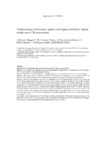Mostrar o rexistro simple do ítem
Epidemiology of traumatic spinal cord injury in Galicia, Spain: trends over a 20-year period
| dc.contributor.author | Montoto-Marqués, A. | |
| dc.contributor.author | Ferreiro-Velasco, M.E. | |
| dc.contributor.author | Salvador-de-la-Barrera, S. | |
| dc.contributor.author | Balboa-Barreiro, Vanesa | |
| dc.contributor.author | Rodríguez-Sotillo, A. | |
| dc.contributor.author | Meijide-Faílde, Rosa | |
| dc.date.accessioned | 2017-09-01T10:20:05Z | |
| dc.date.available | 2017-09-01T10:20:05Z | |
| dc.date.issued | 2017-02-14 | |
| dc.identifier.citation | Montoto-Marqués A, Ferreiro-Velasco ME, Salvador-de-la-Barrera S, Balboa-Barreiro V, Rodríguez-Sotillo A, Meijide-Failde R. Epidemiology of traumatic spinal cord injury in Galicia, Spain: trends over a 20-year period. Spinal Cord. 2017;55:588-594 | es_ES |
| dc.identifier.issn | 1362-4393 | |
| dc.identifier.issn | 1476-5624 | |
| dc.identifier.uri | http://hdl.handle.net/2183/19414 | |
| dc.description.abstract | [Abstract] Study design: Observational study with prospective and retrospective monitoring. Objective: To describe the epidemiological and demographic characteristics of traumatic spinal cord injury (TSCI), and to analyze its epidemiological changes. Setting: Unidad de Lesionados Medulares, Complejo Hospitalario Universitario A Coruña, in Galicia (Spain). Methods: The study included patients with TSCI who had been hospitalized between January 1995 and December 2014. Relevant data were extracted from the admissions registry and electronic health record. Results: A total of 1195 patients with TSCI were admitted over the specified period of time; 76.4% male and 23.6% female. Mean patient age at injury was 50.20 years. Causes of injury were falls (54.2%), traffic accidents (37%), sports/leisure-related accidents (3.5%) and other traumatic causes (5.3%). Mean patient age increased significantly over time (from 46.40 to 56.54 years), and the number of cases of TSCI related to traffic accidents decreased (from 44.5% to 23.7%), whereas those linked to falls increased (from 46.9% to 65.6%). The most commonly affected neurological level was the cervical level (54.9%), increasing in the case of levels C1–C4 over time, and the most frequent ASIA (American Spinal Injury Association) grade was A (44.3%). The crude annual incidence rate was 2.17/100 000 inhabitants, decreasing significantly over time at an annual percentage rate change of −1.4%. Conclusions: The incidence rate of TSCI tends to decline progressively. Mean patient age has increased over time and cervical levels C1–C4 are currently the most commonly affected ones. These epidemiological changes will eventually result in adjustments in the standard model of care for TSCI. | es_ES |
| dc.language.iso | eng | es_ES |
| dc.publisher | Nature | es_ES |
| dc.relation.uri | http://dx.doi.org/10.1038/sc.2017.13 | es_ES |
| dc.title | Epidemiology of traumatic spinal cord injury in Galicia, Spain: trends over a 20-year period | es_ES |
| dc.type | info:eu-repo/semantics/article | es_ES |
| dc.rights.access | info:eu-repo/semantics/openAccess | es_ES |
| UDC.journalTitle | Spinal Cord | es_ES |
| UDC.volume | 55 | es_ES |
| UDC.startPage | 588 | es_ES |
| UDC.endPage | 594 | es_ES |
Ficheiros no ítem
Este ítem aparece na(s) seguinte(s) colección(s)
-
GI-TCMR - Artigos [129]
-
INIBIC-TCMR - Artigos [102]






